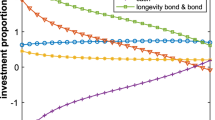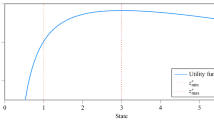Abstract
In this paper, we propose a new target date fund that incorporates human capital. The proposed glide path for the target date fund is based on the capital asset pricing model in a way such that the asset allocation of the target date fund with human capital is matched with that of the global market portfolio with human capital. This new target date fund provides a customized retirement solution satisfying different human capital risk profiles.



Similar content being viewed by others
References
Baxter, M., and U. Jermann. 1997. The international diversification puzzle is worse than you think. American Economic Review 87 (1): 170–180.
Benzoni, L., P. Collin-Dufresne, and R. Goldstein. 2007. Portfolio choice over the life cycle when the stock and labor markets are cointegrated. Journal of Finance 62 (5): 2122–2167.
Bodie, Z., R.C. Merton, and W. Samuelson. 1992. Labor supply flexibility and portfolio choice in a life-cycle model. Journal of Economic Dynamics and Control 16 (3–4): 427–449.
Bruder, B., L. Culerier, L. and T. Roncalli. 2012. How to design target-date funds? Paris, France: Lyxor Asset Management. The Lyxor White Paper No. 9.
Campbell, J. 1996. Understanding risk and return. Journal of Political Economy 104 (2): 298–345.
Campbell, J.Y., J. Cocco, F.J. Gomes, and P. Maenhout. 2001. Investing retirement wealth: A life-cycle model. In Risk aspects of investment-based social security reform, ed. J.Y. Campbell and M. Feldstein. University of Chicago Press.
Cocco, J., F.J. Gomes, and P.J. Maenhout. 2005. Consumption and portfolio choice over the life-cycle. Review of Financial Studies 18: 491–533.
Davis, S., and P. Willen. 2000. Using financial assets to hedge labor income risks: Estimating the benefits, Working Paper, University of Chicago.
Doeswijk, R., T. Lam, and L. Swinkels. 2020. Historical returns of the market portfolio. Review of Asset Pricing Studies 10 (3): 521–567.
Ha, S.and F. J. Fabozzi, 2020. The Global Human Capital Portfolio: Implications for Asset Pricing, Working Paper, Frank J. Fabozzi Associates.
Ibbotson, R.G., and L.B. Siegel. 1983. The world market portfolio. Journal of Portfolio Management 9 (2): 5–17.
Ibbotson, R.G., A. Milevsky, P. Chen, and K.X. Zhu, 2007. Lifetime Financial Advice: Human Capital, Asset Allocation, and Insurance. Charlottesville: CFA Institute Research Foundation.
Idzorek, T., 2008. Lifetime asset allocations: Methodologies for target maturity funds. Ibbotson Research Associates. Available at http://citeseerx.ist.psu.edu/viewdoc/download;jsessionid=CD2E1934221E785860D04F9F1706AD99?doi=10.1.1.183.5994&rep=rep1&type=pdfIbbotson
Jagannathan, R., and Z. Wang. 1996. The conditional CAPM and the cross-section of expected returns. Journal of Finance 51 (1): 3–53.
Jagannathan, R., K. Kubota, and H. Takehara. 1998. Relationship between labor-income risk and average return: Empirical evidence from the japanese stock market. International Journal of Business 71 (3): 319–347.
Lustig, H., and S. Van Nieuwerburgh. 2008. The returns on human capital: Good news on wall street is bad news on main street. Review of Financial Studies 21 (5): 2097–2137.
Markowitz, H.M. 1952. Portfolio selection. Journal of Finance 7 (1): 77–91.
Merton, R.C. 1969. Lifetime portfolio selection under uncertainty: The continuous-time case. Review of Economics and Statistics 51 (3): 247–257.
Sharpe, W.F. 1964. Capital asset prices: A theory of market equilibrium. Journal of Finance 19 (3): 425–442.
Tobin, J. 1958. Liquidity preference as behavior toward risk. Review of Economic Studies 25 (2): 65–85.
Author information
Authors and Affiliations
Corresponding author
Ethics declarations
Conflict of interest
The authors affirm that there is no conflict of interest.
Additional information
Publisher's Note
Springer Nature remains neutral with regard to jurisdictional claims in published maps and institutional affiliations.
Rights and permissions
Springer Nature or its licensor holds exclusive rights to this article under a publishing agreement with the author(s) or other rightsholder(s); author self-archiving of the accepted manuscript version of this article is solely governed by the terms of such publishing agreement and applicable law.
About this article
Cite this article
Ha, S., Fabozzi, F.J. A lifetime allocation with human capital: implications for target date fund. J Asset Manag 23, 365–375 (2022). https://doi.org/10.1057/s41260-022-00278-w
Revised:
Accepted:
Published:
Issue Date:
DOI: https://doi.org/10.1057/s41260-022-00278-w




